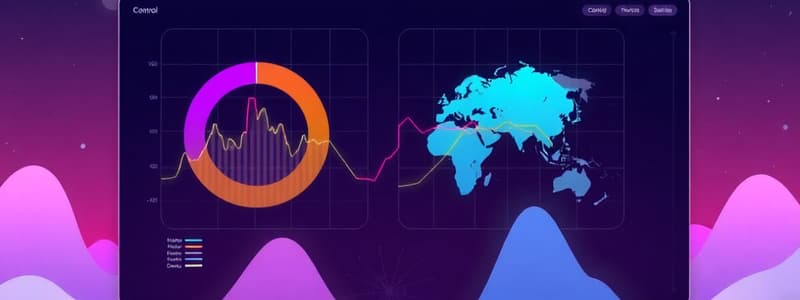Podcast
Questions and Answers
When creating a parameter for 'Standard Deviations' in Tableau for a control chart, what data type should be used?
When creating a parameter for 'Standard Deviations' in Tableau for a control chart, what data type should be used?
- Integer (correct)
- String
- Date
- Boolean
In Tableau, after creating a 'Standard Deviations' parameter, what action makes the parameter dynamically adjustable in the view?
In Tableau, after creating a 'Standard Deviations' parameter, what action makes the parameter dynamically adjustable in the view?
- Apply it to all sheets
- Set it as a global variable
- Show Parameter Control (correct)
- Add it to the Filters shelf
When creating a lower band for a control chart in Tableau, which formula accurately calculates the lower control limit?
When creating a lower band for a control chart in Tableau, which formula accurately calculates the lower control limit?
- WINDOW_AVG(SUM([Defects])) + WINDOW_STDEV(SUM([Defects]) * [Standard Deviations]))
- WINDOW_AVG(SUM([Defects])) * WINDOW_STDEV(SUM([Defects]) - [Standard Deviations]))
- WINDOW_AVG(SUM([Defects])) - WINDOW_STDEV(SUM([Defects]) * [Standard Deviations])) (correct)
- WINDOW_AVG(SUM([Defects])) / WINDOW_STDEV(SUM([Defects]) + [Standard Deviations]))
How can you visually represent the upper and lower bands on a control chart in Tableau?
How can you visually represent the upper and lower bands on a control chart in Tableau?
After adding the upper and lower bands to a dual axis in Tableau, what step is necessary to ensure the bands align correctly with the data?
After adding the upper and lower bands to a dual axis in Tableau, what step is necessary to ensure the bands align correctly with the data?
What is the purpose of creating a calculated field called 'Outliers' in a control chart?
What is the purpose of creating a calculated field called 'Outliers' in a control chart?
In Tableau, how can you modify the appearance of outliers in a control chart to make them more visually distinct?
In Tableau, how can you modify the appearance of outliers in a control chart to make them more visually distinct?
What is the impact of changing the standard deviation slider on outlier identification in a control chart?
What is the impact of changing the standard deviation slider on outlier identification in a control chart?
Suppose you have a control chart showing defects over time, and you increase the 'Standard Deviations' parameter from 2 to 3. What is the likely outcome?
Suppose you have a control chart showing defects over time, and you increase the 'Standard Deviations' parameter from 2 to 3. What is the likely outcome?
In Tableau, if the calculated field for identifying outliers is defined as SUM([Defects]) > [Upper Band] OR SUM([Defects]) < [Lower Band], what does this formula accomplish?
In Tableau, if the calculated field for identifying outliers is defined as SUM([Defects]) > [Upper Band] OR SUM([Defects]) < [Lower Band], what does this formula accomplish?
When creating a control chart in Tableau, after setting up the dual axis for the upper and lower bands, why is it important to 'Synchronize Axes'?
When creating a control chart in Tableau, after setting up the dual axis for the upper and lower bands, why is it important to 'Synchronize Axes'?
You've created a control chart in Tableau and notice that many data points are consistently falling outside the control limits. What might this indicate?
You've created a control chart in Tableau and notice that many data points are consistently falling outside the control limits. What might this indicate?
In Tableau, you want users to be able to easily adjust the number of standard deviations used to define the control limits of your chart. Which feature should you use?
In Tableau, you want users to be able to easily adjust the number of standard deviations used to define the control limits of your chart. Which feature should you use?
You've created a Tableau control chart but the upper and lower bands are just straight horizontal lines, not reflecting the variability in your data. What is MOST likely the problem?
You've created a Tableau control chart but the upper and lower bands are just straight horizontal lines, not reflecting the variability in your data. What is MOST likely the problem?
What is the purpose of using WINDOW_STDEV in the formulas for the upper and lower bands of a control chart?
What is the purpose of using WINDOW_STDEV in the formulas for the upper and lower bands of a control chart?
What does a data point falling outside the control limits in a Tableau control chart typically suggest?
What does a data point falling outside the control limits in a Tableau control chart typically suggest?
When creating a control chart in Tableau, which step ensures that the upper and lower control limits are dynamically calculated based on the data in the view?
When creating a control chart in Tableau, which step ensures that the upper and lower control limits are dynamically calculated based on the data in the view?
When do you typically synchronize dual axes in Tableau?
When do you typically synchronize dual axes in Tableau?
Why might the user want to change the standard deviation on outliers?
Why might the user want to change the standard deviation on outliers?
Flashcards
What is a Parameter in Tableau?
What is a Parameter in Tableau?
A variable that can hold a range of values and be interactively adjusted in Tableau.
What does 'Show Parameter Control' do?
What does 'Show Parameter Control' do?
The option to display the parameter control on a Tableau worksheet for interactive adjustment.
What are Standard Deviation Lines?
What are Standard Deviation Lines?
Lines representing the upper and lower bounds within which data points are considered normal.
What does WINDOW_AVG do?
What does WINDOW_AVG do?
Signup and view all the flashcards
What does WINDOW_STDEV do?
What does WINDOW_STDEV do?
Signup and view all the flashcards
What is a Dual Axis?
What is a Dual Axis?
Signup and view all the flashcards
What is 'Synchronize Axes'?
What is 'Synchronize Axes'?
Signup and view all the flashcards
What are Outliers in Control Charts?
What are Outliers in Control Charts?
Signup and view all the flashcards
What is an 'Outlier' Calculated Field for?
What is an 'Outlier' Calculated Field for?
Signup and view all the flashcards
Why add Outliers to 'Color' on the Marks card?
Why add Outliers to 'Color' on the Marks card?
Signup and view all the flashcards
Study Notes
- Control Charts in Tableau are discussed
Standard Deviations
- Create a parameter named "Standard Deviations"
- The parameter should be an integer
- Allowable range is 1-6
- Click the drop-down and select "Show Parameter Control"
Standard Deviation Lines
- Standard deviation lines are created through calculations
- "Lower Band" equals WINDOW_AVG(SUM([Defects])-WINDOW_STDEV (SUM([Defects]) * [Standard Deviations]))
- "Upper Band" equals WINDOW_AVG(SUM([Defects]) + (WINDOW_STDEV(SUM([Defects]) * [Standard Deviations]))
Visualizing Bands
- Add both of the bands to a dual axis by dragging them to the right side of the viz
- Change their mark types to Line
- Double-click the right axis and check "Synchronize Axes"
Outliers
- Create a calculated field to mark points above or below the bands as outliers
- "Outliers" defined as SUM([Defects]) > [Upper Band] OR SUM([Defects]) < [Lower Band]
- Add outliers to color on the defects marks card
- Changing the standard deviation slider changes outlier identification
Studying That Suits You
Use AI to generate personalized quizzes and flashcards to suit your learning preferences.




